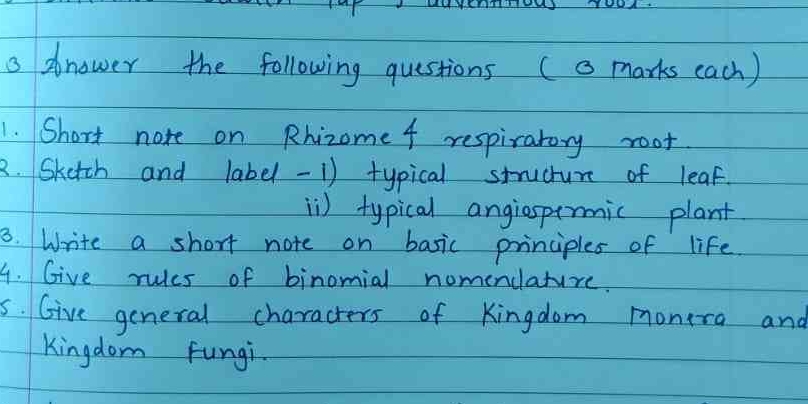1. Short note on rhizome and respiratory root. 2. Sketch and label - i) typical structure of leaf, ii) typical angiospermic plant. 3. Write a short note on basic principles of life... 1. Short note on rhizome and respiratory root. 2. Sketch and label - i) typical structure of leaf, ii) typical angiospermic plant. 3. Write a short note on basic principles of life. 4. Give rules of binomial nomenclature. 5. Give general characters of Kingdom Monera and Kingdom Fungi.

Understand the Problem
The question is asking for detailed explanations and sketches related to various biological topics, including plant structures and classification principles.
Answer
1. Rhizomes store nutrients, respiratory roots aid in gas exchange. 2. Draw and label lamina, petiole in leaves; parts of angiosperm plant. 3. Life principles: organization, metabolism, growth, etc. 4. Binomial rules: Latin, genus/species, format. 5. Monera: prokaryotic; Fungi: eukaryotic, chitin walls.
-
Rhizomes are underground stems that store nutrients and facilitate vegetative reproduction. Respiratory roots, or pneumatophores, are aerial roots that help in gas exchange in waterlogged environments.
-
i) Typical Leaf Structure: A typical leaf has parts like lamina, petiole, and stipules. ii) Typical Angiospermic Plant: Includes root, stem, leaves, flowers, and fruits.
-
Basic principles of life include organization, metabolism, growth, adaptation, response to stimuli, and reproduction.
-
Binomial nomenclature rules: Latin names, two parts (genus and species), italicized or underlined, genus capitalized.
-
Kingdom Monera: Single-celled, prokaryotic, no membrane-bound organelles. Kingdom Fungi: Eukaryotic, cell walls with chitin, heterotrophic, decomposers.
Answer for screen readers
-
Rhizomes are underground stems that store nutrients and facilitate vegetative reproduction. Respiratory roots, or pneumatophores, are aerial roots that help in gas exchange in waterlogged environments.
-
i) Typical Leaf Structure: A typical leaf has parts like lamina, petiole, and stipules. ii) Typical Angiospermic Plant: Includes root, stem, leaves, flowers, and fruits.
-
Basic principles of life include organization, metabolism, growth, adaptation, response to stimuli, and reproduction.
-
Binomial nomenclature rules: Latin names, two parts (genus and species), italicized or underlined, genus capitalized.
-
Kingdom Monera: Single-celled, prokaryotic, no membrane-bound organelles. Kingdom Fungi: Eukaryotic, cell walls with chitin, heterotrophic, decomposers.
More Information
Rhizomes aid in asexual reproduction and survival through adverse conditions. Symbiotic bacteria often associate with respiratory roots.
Tips
For binomial nomenclature, remember to always italicize or underline scientific names and properly capitalize the genus.
Sources
- Rhizome Description - Britannica - britannica.com
- Plant Structures - Courses.lumenlearning.com - courses.lumenlearning.com
- Morphology Of Flowering Plants - BYJU'S - byjus.com
AI-generated content may contain errors. Please verify critical information